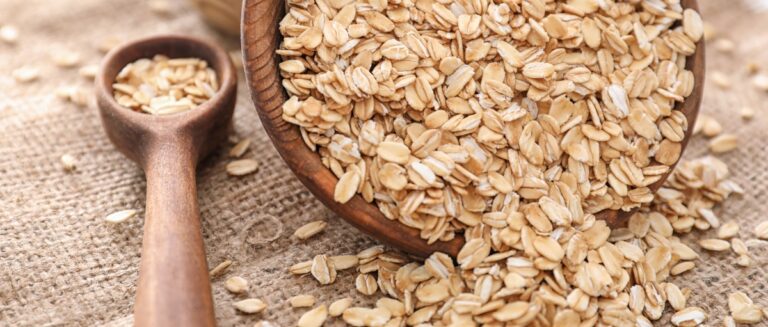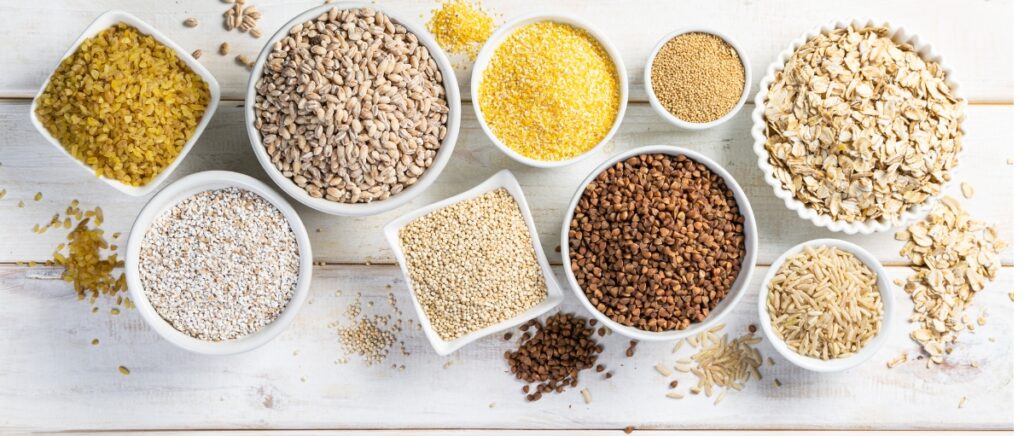We know you’ve seen countless food trends come and go over the years. But there’s one trend that’s here to stay: ancient grains. These nutrient-packed superfoods have been cultivated for thousands of years, but they’re only now gaining widespread popularity in the Western world.
So, what exactly are ancient grains, and why should you care?
Ancient grains are those that have remained predominantly unchanged over the last several hundred years. Unlike modern refined grains, which are heavily processed and stripped of nutrients, old-world grains like quinoa, amaranth, and millet are consumed in their whole, natural form.
Research tells us that ancient grains are loaded with fiber, protein, vitamins, and minerals that can help improve digestion, reduce inflammation, and even lower your risk of chronic diseases like heart disease and type 2 diabetes. A 2016 study out of Harvard Health showed that people who eat more whole grains tend to have a lower risk of premature death from all causes.
If you’re looking for a simple and delicious way to boost your health and vitality, ancient grains or Old World grains are the way to go. In this article, we’ll dive deeper into the fascinating world of ancient grains, exploring their unique nutritional profiles, health benefits, and culinary uses. Additionally, we will provide a comprehensive ancient grains list to highlight these remarkable foods and their diverse applications in modern cooking.
We’ll also share some practical tips and recipes to help you incorporate these superfoods into your diet today.
What are Ancient Grains?
Ancient grains are a category of grains and pseudocereals that have remained largely unchanged over the last several hundred years; hence, they are also called Old World grains. Unlike modern grains like wheat, corn, and rice, which have been heavily processed and refined, ancient grains are consumed in their whole, natural form.
Some examples of ancient grains include:
- Quinoa: A gluten-free pseudocereal that originated in South America and was a staple food of the Inca civilization.
- Amaranth: A tiny, nutrient-packed seed cultivated by the Aztecs and still widely consumed in Mexico and other parts of Latin America.
- Millet: A small, round grain grown in Africa and Asia for thousands of years and is a staple food in many countries.
- Sorghum: It is a gluten-free grain that originated in Africa and is used to make a variety of traditional dishes, including flatbreads and porridges.
- Teff: A tiny, gluten-free grain that is a staple food in Ethiopia and Eritrea and is used to make injera, a traditional fermented flatbread.
Ancient grains are much higher in fiber, protein, vitamins, and minerals than modern refined grains.
- For example, a 100-gram serving of quinoa contains 4.4 grams of fiber, 14.1 grams of protein, and significant amounts of iron, magnesium, phosphorus, and folate.
- In contrast, a 100-gram serving of white rice contains only 0.6 grams of fiber, 2.7 grams of protein, and negligible amounts of vitamins and minerals.
Ancient grains have been an essential part of traditional diets in many cultures for thousands of years. In South America, quinoa was revered by the Inca people as the “mother of all grains” and was used in religious ceremonies. In Africa, sorghum and millet have been cultivated for over 5,000 years and are still a major source of nutrition for millions of people.
Despite their long history and numerous health benefits, ancient grains have only recently gained popularity in the Western world. As more people become interested in whole, unprocessed foods and plant-based diets, ancient grains are experiencing a resurgence in popularity. Many health-conscious consumers now seek ancient grains as a nutritious and delicious alternative to modern refined grains.
Health Benefits of Ancient Grains
Grains from the Old World are not just delicious and versatile; they also offer a wide range of health benefits that make them a valuable addition to any diet. Here are some of the key ways in which ancient grains can improve your health:
Nutrient-Dense Superfoods
One of the main advantages of ancient grains is their exceptional nutrient density. Compared to modern refined grains, which are often stripped of their bran and germ layers during processing, ancient grains are typically consumed in their whole form, retaining their natural goodness.
Ancient grains are exceptionally high in:
- Fiber: Essential for healthy digestion, blood sugar control, and heart health.
- Protein: Important for building and repairing tissues and keeping you feeling full and satisfied.
- Vitamins and minerals: Including B vitamins, iron, magnesium, phosphorus, and zinc, which are crucial for various bodily functions.
Improved Digestion and Gut Health
The high fiber content of ancient grains is particularly beneficial for digestive health. Fiber helps to promote regular bowel movements, prevent constipation, and maintain a healthy gut microbiome.
Moreover, some ancient grains, such as millet and sorghum, contain resistant starch, a type of fiber not fully broken down and absorbed in the small intestine. Instead, it reaches the large intestine, ferments, and feeds the beneficial bacteria in the gut. This process can help to improve gut health, boost immunity, and reduce inflammation.
Reduced Inflammation and Chronic Disease Risk
Inflammation is a natural immune response, but chronic inflammation can contribute to the development of various diseases, such as heart disease, type 2 diabetes, and certain cancers. Ancient grains are rich in antioxidants, which are compounds that help combat oxidative stress and reduce inflammation in the body.
For instance, quinoa is a good source of flavonoids, including quercetin and kaempferol, which have been shown to have anti-inflammatory and anti-cancer properties. Similarly, amaranth contains phenolic acids, which are powerful antioxidants that can help protect against chronic diseases.
Studies have also suggested that regular consumption of whole grains, including ancient grains, may help lower the risk of heart disease, type 2 diabetes, and certain cancers. For example, a large meta-analysis published in the British Medical Journal found that regularly eating whole grains was associated with a lower risk of cardiovascular disease and all-cause mortality.
Better Blood Sugar Control
Ancient grains typically have a lower glycemic index compared to refined grains, meaning they cause a slower and more gradual rise in blood sugar levels after eating. This is important for maintaining stable energy levels and reducing the risk of type 2 diabetes.
For example, quinoa has a glycemic index of 53, considered low, while white rice has a glycemic index of 73, considered high. Consuming foods with lower glycemic indexes can help improve insulin sensitivity and reduce the risk of developing type 2 diabetes over time.
The exceptional nutrient density, digestive health benefits, anti-inflammatory properties, and blood sugar-regulating effects of ancient grains make them a powerful tool for promoting overall health and well-being. By incorporating a variety of ancient grains into your diet, you can reap the numerous benefits of these nutritious and delicious superfoods.
The Ancient Grains List
Now that you understand ancient grains’ impressive health benefits, let’s examine some of the most popular varieties and their unique characteristics.
Quinoa
Quinoa, pronounced “keen-wah,” is a gluten-free pseudocereal that originated in the Andean region of South America. It was a staple food of the Inca civilization and is often called the “mother of all grains.”
Key features:
- Complete protein source containing all nine essential amino acids.
- High in fiber, magnesium, phosphorus, and folate.
- Gluten-free and suitable for those with celiac disease or gluten sensitivity.
- Versatile and easy to cook, with a light, fluffy texture and nutty flavor.
Culinary uses: Quinoa can be used as a substitute for rice in various dishes, such as pilafs, salads, and stir-fries. It also works well in breakfast porridge and can be added to soups and stews for extra protein and texture.
Amaranth
Amaranth is a tiny, gluten-free pseudocereal that the Aztecs cultivated in ancient Mexico. It is known for its impressive nutrient profile and distinctive flavor.
Key features:
- High in protein, fiber, and essential minerals like iron, magnesium, and phosphorus.
- It contains unique antioxidants, such as gallic acid and rutin, which may be anti-inflammatory.
- It is gluten-free and suitable for those with celiac disease or gluten sensitivity. It has a slightly peppery and nutty taste.
Culinary uses: Amaranth can be cooked and consumed as a hot cereal or porridge, similar to oatmeal. It can also be popped like popcorn for a crunchy, nutritious snack or added to baked goods to boost protein and fiber.
Millet
Millet is a small, gluten-free grain cultivated in Africa and Asia for thousands of years. It is a staple food in many countries known for its nutrient density and versatility.
Key features:
- It is rich in fiber, protein, and essential minerals like magnesium, phosphorus, and manganese.
- It contains antioxidants, such as phenolic acids and flavonoids, which may help reduce inflammation.
- Gluten-free and suitable for those with celiac disease or gluten sensitivity.
- When cooked, it has a mild, slightly sweet flavor and a light, fluffy texture.
Culinary uses: Millet can be used as a substitute for rice or couscous in various dishes, such as pilafs, salads, and stuffed vegetables. It can also be ground into flour and used in gluten-free baking.
Sorghum
Sorghum is a gluten-free grain originating in Africa and is now widely cultivated worldwide. It is known for its drought-resistant properties and nutritional benefits.
Key features:
- It is high in fiber, protein, and essential minerals like magnesium, phosphorus, and iron.
- It contains beneficial plant compounds, such as anthocyanins and phenolic acids, containing antioxidant properties.
- Gluten-free and suitable for those with celiac disease or gluten sensitivity.
- When cooked, it has a mild, slightly sweet flavor and a chewy texture.
Culinary uses: Sorghum can be used instead of rice or quinoa in various dishes, such as pilafs, salads, and grain bowls. It can also be ground into flour, used in gluten-free baking, or popped like popcorn for a nutritious snack.
Teff
Teff is a tiny, gluten-free grain that originated in Ethiopia and Eritrea. It is a staple food in these countries known for its impressive nutrient profile and unique flavor.
Key features:
- It is high in fiber, protein, and essential minerals like iron, calcium, and magnesium.
- It contains vitamin C, which is rare for grains.
- Gluten-free and suitable for those with celiac disease or gluten sensitivity.
- Has a mild, slightly sweet, and nutty flavor.
Culinary uses: Teff is commonly used to make injera, a traditional Ethiopian fermented flatbread. It can also be used in porridges, stews, and baked goods, such as bread and muffins, for a nutrient boost and unique flavor.
Incorporating these diverse and nutritious ancient grains into your diet allows you to enjoy a wide range of flavors, textures, and health benefits while exploring new and exciting culinary possibilities.
Is Wild Rice an “Ancient Grain?”
Wild rice, known for its distinct dark look, chewy texture, and earthy flavor, is far more beneficial than traditional white or brown rice. However, wild rice is not technically an “ancient grain” because it’s not a grain at all but rather an aquatic grass.
Still, it’s a fantastic substitute for conventional grains.
Traditionally, wild rice was hand-harvested from canoes in shallow lakes and rivers. This practice continues today among some Indigenous communities, preserving ancient techniques and cultural traditions. The harvesting process involves gently knocking the ripe seeds into the canoe using special wooden sticks, which have remained largely unchanged for centuries.
As an honorary ancient grain, wild rice boasts an impressive nutritional profile:
- High in protein and fiber
- Rich in minerals and vitamins
- Contains powerful antioxidants
- Low in fat
These nutritional characteristics make wild rice valuable to modern diets, aligning with current health trends focused on whole grains and plant-based proteins.
Incorporating Ancient Grains into Your Diet
Now that you’re familiar with the incredible health benefits and diverse variety of ancient grains, you may wonder how to start incorporating them into your diet. Here are some simple tips and strategies to help you get started:
Start with Familiar Recipes
One of the easiest ways to introduce ancient grains into your diet is by substituting them for refined grains in your favorite recipes. For example:
- Replace white rice with quinoa or millet in stir-fries, pilafs, and side dishes
- Swap out wheat flour for sorghum or teff flour in gluten-free baking recipes
- Use amaranth or quinoa instead of oats in your morning porridge or overnight oats
By making these simple substitutions, you can boost the nutritional value of your meals without drastically changing the flavors or textures you enjoy.
Experiment with New Recipes
As you become more comfortable with ancient grains, try experimenting with new recipes and flavor combinations. Here are a few ideas to get you started:
- Toss cooked sorghum or farro with roasted vegetables, fresh herbs, and a zesty dressing for a hearty and nutritious grain salad
- Stuff bell peppers or zucchini with a mixture of quinoa, black beans, and spices for a satisfying vegetarian main course
- Create a warm and comforting millet porridge with cinnamon, nuts, and fresh fruit for a nourishing breakfast or snack
Don’t be afraid to get creative in the kitchen and explore each ancient grain’s unique flavors and textures.
Cook Grains in Bulk
To make incorporating ancient grains into your diet even easier, consider cooking them in bulk and storing them in the refrigerator or freezer for quick and convenient meals throughout the week.
Most ancient grains can be cooked using a simple stovetop method or in a rice cooker, and they keep well in airtight containers for several days.
Having a supply of pre-cooked ancient grains on hand makes it easy to:
- Add a scoop of quinoa or millet to your morning smoothie for a protein and fiber boost
- Toss a handful of cooked sorghum or farro into your favorite soup or stew for added texture and nutrition
- Create a quick and easy grain bowl with leftover grains, veggies, and your choice of protein
By cooking ancient grains in bulk, you’ll always have a nutritious and delicious base for your meals, even on the busiest of days.
Look for Ancient Grain Products
As ancient grains continue to gain popularity, more and more products featuring these nutritious ingredients are becoming available in grocery stores and online. Keep an eye out for:
- Breads, tortillas, and wraps made with quinoa, sorghum, or teff flour
- Cereals and granolas featuring a blend of ancient grains like millet, amaranth, and quinoa
- Pasta made from quinoa, amaranth, or a combination of ancient grains and legumes
By incorporating these convenient products into your diet, you can easily boost your intake of ancient grains without spending hours in the kitchen.
The Science Behind Swapping In Ancient Grains
In a randomized crossover trial published in the International Journal of Food Sciences and Nutrition in 2016, researchers investigated the cardiovascular benefits of consuming bread made with ancient grains compared to modern wheat.
The study involved 45 healthy adults, with an average age of 50, who consumed bread made from ancient grains (Verna, Gentil Rosso, and Autonomia B) and modern wheat (Blasco) in different 8-week phases.
After consuming bread made from ancient grains for 2 months, the following results were observed:
- Total cholesterol levels decreased significantly.
- LDL (“bad”) cholesterol levels decreased significantly.
- Blood glucose levels decreased significantly.
Perhaps, most interesting, there was a substantial increase in circulating endothelial progenitor cells, which repair damaged blood vessels, after consuming bread made from the ancient grain Verna.
The researchers concluded that consuming ancient grains as part of a healthy diet could help lower cholesterol and blood glucose levels, which are leading risk factors for heart attack and stroke.
Embrace the Power of Ancient Grains for Lifelong Health
Ancient grains are a true gift from nature, offering an impressive array of health benefits and culinary possibilities. By incorporating these nutritious and delicious grains into your diet, you can:
- Boost your intake of essential vitamins, minerals, fiber, and protein.
- Support healthy digestion and gut function.
- Reduce inflammation and lower your risk of chronic diseases.
- Enjoy a diverse range of flavors and textures in your meals.
Embracing the power of ancient grains is one of the best things you can do for your health and well-being. Start by experimenting with one or two new grains, and gradually expand your repertoire as you discover new favorites.
Remember, it’s never too late to change your diet and lifestyle positively. By nourishing your body with the wisdom of the ancients, you can look forward to a vibrant, energetic, and fulfilling life for years to come.
Sources
Harvard Health Publishing. (2016, June 29). Ancient vs. modern grains – Are they good for you? Harvard Health. https://www.health.harvard.edu/blog/ancient-vs-modern-grains-theyre-good-201606299876
Rogers Foods. (n.d.). Healthy ancient grains: What are they & why you need to include them in your diet. Rogers Foods. https://rogersfoods.com/healthy-ancient-grains-what-are-they-why-you-need-to-include-them-in-your-diet/
Medical News Today. (2023, February 16). Ancient grains may help treat type 2 diabetes. Medical News Today. https://www.medicalnewstoday.com/articles/ancient-grains-may-help-treat-type-2-diabetes
Harvard Health Publishing. (2022, February 1). Whole grains associated with lower death rates. Harvard Health. https://www.health.harvard.edu/nutrition/whole-grains-associated-with-lower-death-rates
Discover Peru. (n.d.). Native crops of Peru: Quinoa. Discover Peru. http://www.discover-peru.org/native-crops-of-peru-quinoa/
Sorghum Growers. (2020, March). The global significance of sorghum in Africa. Sorghum Growers Magazine. https://sorghumgrowers.com/magazine/the-global-signficance-of-sorghum-africa/
Poutanen, K., Flander, L., & Katina, K. (2009). Sourdough and cereal fermentation in a nutritional perspective. Food Microbiology, 26(7), 693-699. https://www.ncbi.nlm.nih.gov/pmc/articles/PMC3435786/
Johns Hopkins Medicine. (n.d.). Fight inflammation to help prevent heart disease. Johns Hopkins Medicine. https://www.hopkinsmedicine.org/health/wellness-and-prevention/fight-inflammation-to-help-prevent-heart-disease
Turcinov, D., & Stankovic, M. (2023). A systematic review of the health outcomes of grain consumption among HIV-positive individuals. AIDS Care, 35(11), 1523-1532. https://doi.org/10.1080/09540105.2023.2265690
Sadeghi, M. R., & Mohammadi, R. (2019). Whole grains in relation to lower blood pressure: A review of observational and interventional studies. Journal of Clinical Medicine, 8(1), 68. https://www.ncbi.nlm.nih.gov/pmc/articles/PMC6617258/
Santos, M. L., & Silva, R. F. (2016). The potential role of whole grains in the prevention of metabolic syndrome. Nutrients, 8(3), 160. https://www.ncbi.nlm.nih.gov/pmc/articles/PMC4908315/
Erkkilä, A. T., & Mikkilä, V. (2014). Whole grain intake and cardiovascular disease: A systematic review and meta-analysis. British Journal of Nutrition, 112(1), 110-120. https://doi.org/10.1017/S0007114514001733
Tarnowski, D. (2022, November 8). Gold of the U.S.: Native American nations struggle to protect wild rice. Sierra Club. https://www.sierraclub.org/sierra/gold-us-native-american-nations-struggle-protect-wild-rice
ScienceDaily. (2016, September 28). Ancient grains offer new opportunities to improve nutrition. ScienceDaily. https://www.sciencedaily.com/releases/2016/09/160928135900.htm











